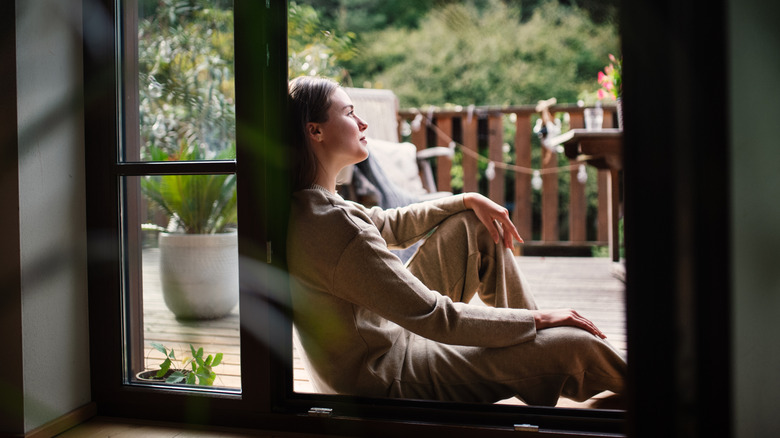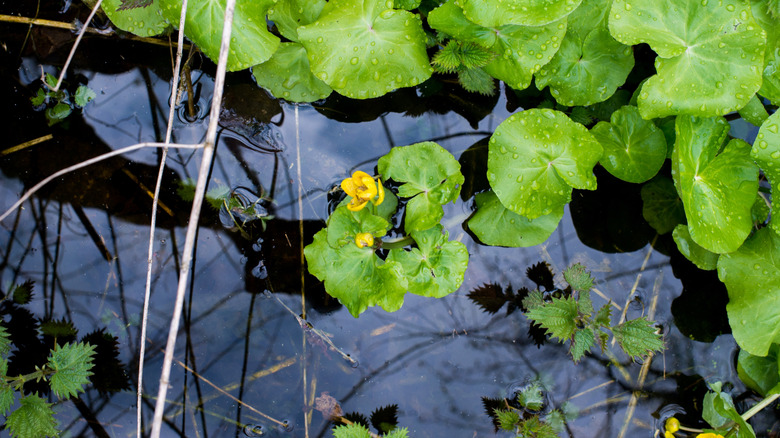Make A DIY Balcony Pond To Add Serene Beauty To Your Home
We may receive a commission on purchases made from links.
A balcony is a little slice of Zen for apartment dwellers. Relaxing in this outdoor private space with a good book, your favorite drink, or family and friends can be a highlight of the warmer months. For people who work remotely, moving the laptop out to the balcony table or taking breaks to spend time there has been shown to lessen stress, improve moods, and bolster energy and focus levels during the workday. These are among the many mental and physical health benefits that can result from even brief contact with nature. Even if your space doesn't come with a view of lush greenery, you can surround yourself with serene beauty by making a DIY balcony pond.
To construct this mini oasis, you'll be following the steps to make an above-ground pond while tweaking the process to make it suitable for your balcony. The essentials are a waterproof container, gravel, and some form of aeration. With these basics in place, there's room for creativity and customization as you choose water-loving plants, fish, and decorative features.
Pick the right balcony pond container
No matter how little balcony space you have, there's a good chance you can find a container for your pond. Pots used for planting and livestock water tanks are some options you can choose from, depending on the available space, the types of water plants you desire, and whether you want fish. On a balcony, you'll most likely want a container on the small side. It's important that the container is watertight, especially if the balcony has wood flooring, to avoid damage from leaking.
There is one material you should never use for a balcony pond if you hope to make it a home for fish: galvanized steel. Building a koi pond in galvanized steel containers could turn deadly for fish because they are not able to tolerate the level of zinc that builds up in the water. For balconies that are particularly sunny, it's smart to opt for stone or ceramic and avoid plastic, which may not hold up well in the heat over time.
Place gravel on the bottom of your pond, which will add to its natural beauty while nurturing the good bacteria that fish feed on. Pea gravel or sand are nice choices, but feel free to add larger rocks or even bricks, which can prop up some plants so they sit closer to the water surface. The next step is to add plants, and — if you're able to provide a safe, aerated environment for them — fish. The beauty of placing the pond on the balcony means you can easily move the fish inside to a tank in the colder months. There are different options for aeration that can fit in a small pond, such as the NFESOLAR 4W Solar Aerator, which comes with a battery backup.
The best plants for your balcony pond
The plants in your balcony pond can be potted and placed on top of the gravel, rocks, or bricks you use. A variety of plants adds to the calming appearance and functionality of the pond, and, if you look for native plants that favor damp soil, may even nurture dragonflies. These types of native plants, known as "marginal plants," can grow in a shallow balcony pond. The bright yellow marsh marigold (Caltha palustris) requires constant moisture, making it a great choice, and pickerelweed (Pontederia cordata L.), growing with its stem underwater, is known for its striking purple flowers.
Other plants you'll want to keep in your pond that will also help attract dragonflies include varieties that can float and benefit the pond ecosystem. A classic floating plant choice is the American white water lily (Nymphaea odorata Aiton), but there's also a smaller hybrid called the hardy water lily (Nymphaea "Pygmaea Helvola") that only needs 3 square feet of water surface area for its leaves and flowers to grow. The leaves shelter fish and help naturally add oxygen to the water.
Pond grasses that are native to your area don't just add a pop of green; they also help absorb any excess nutrients that accumulate in the water to help keep it filtered. They can even keep algae from growing, allowing you to enjoy an unobstructed view of your underwater habitat.

